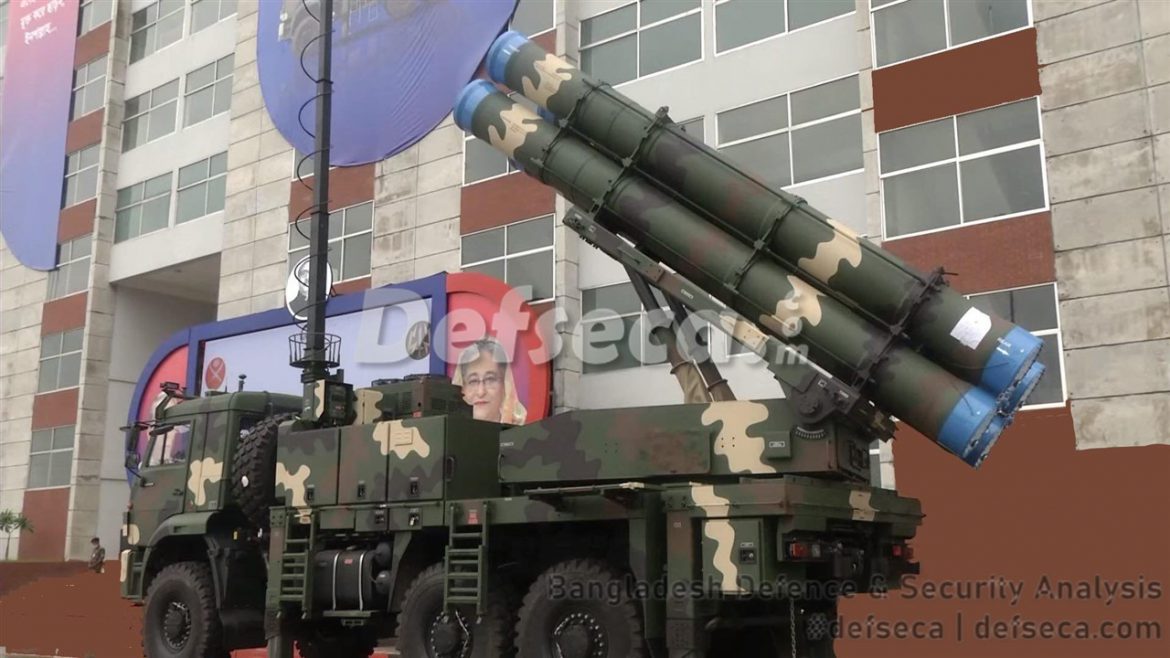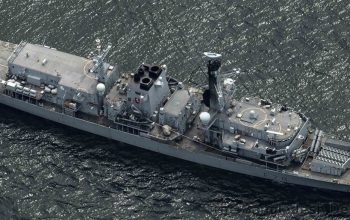Turkey, a powerful NATO-member country has opened its doors for greater defence cooperation with the Bangladesh Armed Forces. As a sign of growing defence cooperation between Bangladesh and Turkey the Bangladesh Army has started procuring respectable numbers of Turkish-made defence equipment from its state owned enterprises such as Roketsan, Aselsan and also private holding companies including Otokar.
Several key hardware contracts have been reportedly awarded to Roketsan, which manufactures large calibre missiles, rockets, guidance systems and launchers.
Last month the Bangladesh Army inducted the first battery of the Tiger Missile System, which is a multi-calibre guided MLRS system capable of striking targets out to a maximum of 120 km using 302 mm and 230 mm rockets/missiles. Over 180 Bangladesh Army personnel took training in Turkey to become competent in operating such an advanced platform, based on the venerable Kamaz chassis, favoured by the Artillery corps.
Air Defence branch of the Artillery Corps have also initiated a contract for advanced medium range surface to air missile systems from Aselsan/Roketsan, however details are yet to be officially disclosed to the public.
Turkish defence industry offers several products which can be inducted in to the Bangladesh Army to realise the Forces Goal 2030 of the military modernisation blueprint. In this paper I will propose induction of towed howizters, self-propelled howitzers, mortars, air defence systems which can enhance the operational capabilities of the Bangladesh Army.
Mortars
Turkish manufacturers such as MKEK and ASELSAN offer both towed and self-propelled mortar weapon system, which would be ideal for the Bangladesh Army because 120mm mortar systems were reintroduced in to the inventory following adoption of new war-fighting strategies, which intends to exploit the inherently advantageous characteristics of the heavy mortars.
MKEK can be tapped to supply the 620-kg rifled heavy mortar designated as HY1-12, which has a maxmum range of 8,000 m.
Moreover, ASELSAN’s Alkar 120 mm mortar weapon system, which mounts a 120 mm rifled mortar system with a 4×4 high-mobility, armoured car chassis can be incorporated in to the mechanised infantry forces inventory. The Alkar is particularly flexible given that the system can integrate rifled or smoothbore mortar barrel of any model, including those currently used by the Bangladesh Army.
The Alkar is equipped with an automatic fire loading system and automatic fire control system. It can offer a quantum leap in terms of rapid mobility and fire power to infantry units of the Bangladesh Army.
Towed howitzers
MKEK designed a lightweight air-transportable towed howitzer of 105 mm/30 calibre capable of supporting commando and airborne operations. The 1,710 kg weapon system is equipped with a fire control system and can be transported on Mi-171Sh helicopter or C295W fixed wing transport aircraft of the Bangladesh Army. Known as the ‘Boran’ air transportable light towed howitzer, it is capable of being operated consciously for eight hours in temperatures of -33⁰ C and +44⁰ C. The Boran is equipped with GPS and panoramic cannon binocular. It has an effective range of 17 km and can be deployed independently or part of classic artillery TO&E.
Next up of course we have the Patner 155mm/52 cal. APU-equipped howitzer, which has a combat weight of 18,000 kg and a maximum range of 40 km using ERFB/BB munitions. The system is equipped with a modern fire control system that can strike targets with high precision. Since there is an outstanding requirement for 18 towed howitzers per Infantry Division’s artillery brigade induction of such a system would significantly increase the capabilities of the Bangladesh Army compared to existing holding of 130mm Type 59-1 towed howitzers brought from China and Iraq.
Self-propelled howitzers
Mechanised infantry divisions, of which two are planned to be converted from existing Infantry Divisions require self-propelled howitzers. The Bangladesh Army acquired at least one regiment of Nora B-52/K1 155mm/52 calibre self-propelled howitzers from Serbia through Yugoimport. The weapons platforms initially experienced teething issues in relation to their air conditioning systems according to Defseca.com’s sources. Those problems have been rectified by the manufacturer.
However I propose addition of the Yavuz self-propelled truck mounted artillery system, which mates the Panter howitzer with a 6×6 high mobility truck. The SPH vehicle carries 18 ready to fire rounds and can be operated by a crew of 5 personnel, who are fully protected against CRBN threats from within the armoured cabin.
Rocket systems
As the Bangladesh Army already standardised and incorporated the Tiger missile system (Type B category) in to its echelon there remains an outstanding requirement to add a 300 km range Type A Guided Multiple Launch Rocket System (GMLRS).
In this regard ROKETSAN is well and truly capable of meeting the requirements of the Bangladesh Army with the Khan Missile system. According to available marketing literature from the OEM, the weapon system can raindown accurate and effective firepower on strategic targets within the battlefield. The missile can be launched from existing Multi-Calibre Launcher or MCL that are already inducted in to the Bangladesh Army in form of the Tiger missile system, which will result in economic and logistical advantage over rival offerings from China and Russia.
The Khan Missile system can be operated in all weather conditions and is equipped with anti-jamming solutions. The missile itself has a diameter of 610 mm and weight of 2,500 kg. It achieves guidance through GPS + GNSS + INS or INS only modes. Its powerful 470 kg warhead is armed with HE-frag and its fuse incorporates both point detonation and proximity sensors. Accuracy is ≤ 10 m GPS + GLONASS Aided INS or ≤ 100 m INS Only mode.
Anti-aircraft guns
The Bangladesh Army has a very large requirement for towed and self-propelled anti-aircraft gun of 35 mm calibre based on the GDF-pattern. The Army hinted at the possibility of procuring both Chinese and original-Swiss made production models to fulfil their requirements.
Due to prohibited high cost of the Swiss-made GDF-009 I strongly recommend the Bangladesh Army look in to procurement of the equally modern GDF-003B twin-barrel anti-aircraft gun system from Turkey, which is manufactured by MKEK through licenced production and maintenance from the OEM. The system has an effective range of 4,200 m against air targets and a rate of fire of 550 rounds per minute. It is capable of firing air-burst munitions developed by Turkey and has been fully modernized by ASELSAN to meet present and future battlefield tactical requirements. This is suitable for air defence artillery regiments of the Bangladesh Army, which are currently equipped with older generation Chinese 37mm Type 55/74 anti-aircraft guns.
ASELSAN, which offers many advanced systems has developed a self-propelled, futuristic air defence gun system developed for the effective air defence of mechanised infantry troops and other rapid fighting units. Known as the Korkut, the system has a firing on the move capability and can be operated remotely through the unmanned gun turret. It incorporates the MKEK built GDF-003B 35mm gun system and the advanced air burst ammunition that can effectively counter air-to-ground missiles, cruise missiles, UAVs and slow moving aircraft. The Korkut is mounted on a tracked chassis.
Air defence missile systems
ROKETSAN and ASELSAN developed and manufactured Hisar air defence missiles offers the Bangladesh Army a new self-defence capability against rotary and fixed wing aircrast as well as cruise missiles, air-to-ground missiles and unmanned aerial vehicles. The Hisar can protect KPIs such as military bases, ports, facilities and troops.
The Hisar is offered in multiple variant each graded on range characteristics. The Hisar-O+, which may have already been incorporated in to the Bangladesh Army, but not disclosed formally yet has a range of 45-60 km and an effective range of 25 km. It is a vertically launched weapon system mounted on a Mercedes Benz 6×6 cross-country chassis manufactured under-licence in Turkey.
The Bangladesh Army can opt for the long range Hisar-U air defence system, which can directly compete against S-350 and FK-3 air defence systems from Russia and China respectively.
Conclusion
There should be no doubt that Turkey offers the Bangladesh Armed Forces a ready supply of advanced defence material technologies and a strategic reliability without strings attached. Turkey is also flexible offering defence equipment supply in advanced while Bangladesh Army pays in installments opening up option for inducting more military hardware within a shorter period of time.
But perhaps the most positive aspect of acquiring defence equipment with Turkey is the fact that the Eurasian country offers Bangladesh a comprehensive technology transfer package where it is readily willing to handover its advanced technologies to develop Bangladesh’s nascent defence industries.
It is my strong belief that Bangladesh and Turkey will continue to expand military cooperation in a meaningful, transparent way that exemplifies East-West cooperation. Within the next 5 years Defseca.com projects Turkey will become one of the top 5 defence equipment suppliers to Bangladesh through the ongoing supply and transfer of military technologies.




